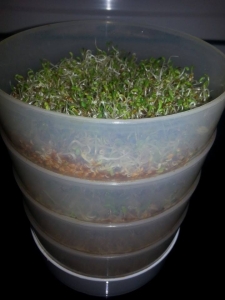Links to check out, especially if you live in an area where giant hogweed is present; it’s good to see the various photos of the plant:
Plant geek info:
Family: Apiaceae (or Umbelliferae)
Genus: Heracleum
Species: mantegazzianum
Common names: giant hogweed, cartwheel-flower, giant cow parsnip,”hogsbane” or giant cow parsley (source)
Thanks for reading. If you enjoyed this post, please click the “LIKE” button and consider subscribing via email, Twitter , Pinterest or your favorite reader.
*****************************************************************************************************************************************
Below is the post from jim mcdonald:
the obligatory annual GIANT HOGWEED post; please feel free to share or copy and paste it onto any and all of the hundred thousand threads on the topic:
Giant hogweed possesses the same photosensitizing compounds found in parsnip (and not just wild parsnip, as “garden parsnip” and “wild parsnip” are the *same* species, Pastinaca sativa). It’s the sap that’s so bad; if you just touch the plant you won’t melt like the wicked witch in the Wizard of Oz… But *don’t* try pulling it up or chopping it down. The plant is freakin’ huge, so pretty easy to ID. It’s not like you won’t notice it.
Cow parsnip, hogweed and wild parsnip are of a wholly different breed than poison ivy; the sap contains furocoumarins and is photosensitizing, it increases the effects for sun exposure. Here’s a nice overview, as related to wild parsnip (but, again, it applies to garden & cow parsnip and hogweed):
“This section is adapted from the excellent article on wild parsnip burns by David Eagan (1999). Wild parsnip is of concern because humans develop a severe skin irritation from contact with its leaves. Plants have chemicals called psoralens (more precisely, furocoumarins) that cause phyto-photodermatitis: an interaction between plants (phyto) and light (photo) that induce skin (derm) inflammation (itis).
Once the furocoumarins are absorbed by the skin, they are energized by uv light on both sunny and cloudy days. They then bind to DNA and cell membranes, destroying cells and skin. Parsnip burns usually occur in streaks and elongated spots, reflecting where a damaged leaf or stem moved across the skin before exposure to sunlight.
Wild parsnip burns differ from the rash caused by poison ivy in several aspects. First, everyone is sensitive to wild parsnip and you do not need to be sensitized by a prior exposure to develop burns or blisters. You can brush against wild parsnip plants and not be affected. Parsnip is only dangerous when the plant sap from broken leaves or stems gets on your skin. Lastly, the wild parsnip’s “burn” is usually less irritating that poison ivy’s “itch.” The worst of the burning pain caused by wild parsnip is usually over within a couple of days while the rash and itch of poison ivy can last a long time.
In cases of mild exposure to wild parsnip, affected areas turn red and fell sunburned. In severe cases, the skin first turns red and then blisters form. The arms, legs, torso, face, and neck are most vulnerable and affected areas may feel like they have been scalded. Blisters form a day or two after sun exposure and soon after the blisters rupture and the skin starts healing. But for many people the ordeal is not over as dark red or brownish “scars” remain in the burned areas for several months to years. Animals can also get parsnip burns if they have little hair and lightly pigmented skin, characteristics that allow the chemical and sunlight to reach the skin.
The burning sensation can be relieved by covering the affected areas with a cool, wet cloth. Try to delay blisters from rupturing as long as possible as blisters protect the skin by keeping it moist and clean while the areas heal. For those cases with extensive blistering, consult a doctor.
Tips to avoid exposure include wearing gloves, long pants, and long-sleeved shirts. Planning control activities for the early evening will minimize sunlight and thus activation of the blistering process. If you are exposed to the plant juice, wash the contaminated areas thoroughly as soon as possible.”










